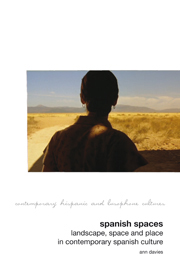Book contents
- Frontmatter
- Contents
- Acknowledgements
- List of illustrations
- 1 Introduction
- 2 Memory: landscapes of the past in Guillermo del Toro's Spanish films
- 3 Forgetting: the landscapes of Gonzalo Torrente Ballester
- 4 Landscape and identities in the Basque Country
- 5 Crime scene: landscape and the law of the land
- 6 Crime, scene, investigation: women, detection and the city
- 7 Coasting: tourism and landscape
- 8 Immigration: north (of) Africa
- 9 Conclusion
- Filmography
- Bibliography
- Index
4 - Landscape and identities in the Basque Country
- Frontmatter
- Contents
- Acknowledgements
- List of illustrations
- 1 Introduction
- 2 Memory: landscapes of the past in Guillermo del Toro's Spanish films
- 3 Forgetting: the landscapes of Gonzalo Torrente Ballester
- 4 Landscape and identities in the Basque Country
- 5 Crime scene: landscape and the law of the land
- 6 Crime, scene, investigation: women, detection and the city
- 7 Coasting: tourism and landscape
- 8 Immigration: north (of) Africa
- 9 Conclusion
- Filmography
- Bibliography
- Index
Summary
If landscape, space and place can be used as a way of seeing past traumas and the way in which they haunt the present, they can also be used to see present traumas, too. One of the most enduring legacies of Franco's dictatorship is the sometimes violent struggle over the political position of the Basque Country, in the north of the Iberian peninsula: although the roots of the Basque nationalist movement promoting greater autonomy or outright independence from Spain go further back in time than the Franco period, the dictatorship added a new edge to calls for a recognition of the Basque Country as a nation, since Francoist ideology opposed any expression of regional identity that might presuppose a national identity separate from that of Spain. Franco believed that Spain should be kept whole, united and indivisible. The Basque Country was not alone in suffering political and cultural repression as a result – Catalonia and Galicia, the other familiar ‘historical nationalities’ of Spain, also saw their cultural and political freedoms severely curtailed – but only in the Basque Country did local reaction amount to a sustained campaign of violent rebellion, now commonly recognised in the democratic era as terrorist.
My purpose in this chapter is to consider Rose's call to care in the light not only of the ongoing political conflict but also of a well established landscape tradition in the Basque Country that itself is closely bound up with Basque nationalist ideas and ideologies, although not necessarily synonymous with them. Landscape, space and place can be redolent of nationalism as well as nation, as is exemplified by the link commonly made between rural and mountainous landscape and Basque nationalism.
- Type
- Chapter
- Information
- Spanish SpacesLandscape, Space and Place in Contemporary Spanish Culture, pp. 60 - 81Publisher: Liverpool University PressPrint publication year: 2012

